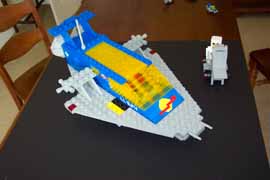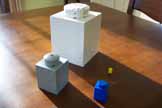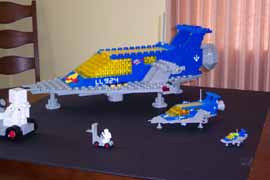
It's all a matter of scale
Like Alice in Wonderland, we're going to be seeing the world a bit differently on this webpage; our whole sense of scale is going to change. Things will grow larger; things will grow smaller... but it's all in the name of fun.
In early August 2003 while in California preparing for the Ripley's Believe It Or Not! silliness, I had dinner with a couple of friends-in-LEGO. One of them, Anne Carasik, has, in the past, built a large scale LEGO 'mini-figure'; a little guy in the 'Classic Space' theme. While we were discussing this and other LEGO projects, I commented, "wouldn't it be cool to build a scaled up version of some Classic Space set? Like the whole set?"
Now, scaled up bricks are not a new idea. I had built a "mega-scale-figure" myself early in my sculpting career: a classic LEGO Knight. I saw someone's display of large bricks made from small bricks at Brickfest this year. I remember someone at Electronic Arts had similar models in their cubicle (I can't remember who he was [update: it was Nick Corea]). LEGO enthusiast John Neal posted about the topic on LUGNET back in 2001. That post really impressed me. The enlarged bricks his son had built were beautiful scale models of the basic geometric LEGO brick. Those images were in my mind when I made my comment about an enlarged Classic Space set.
Fortunately for me I thought of this idea the week before Brickfest 2003. There were to be many people at the LEGO convention selling and trading pieces, so with a particular project in mind, I was able to look for the exact pieces I knew I would need.
I decided that my focus would be one of my favorite sets growing up. The LL924 Space Cruiser (this set was actually number 487 in the United States, but since the printed brick on the ship reflects the non-U.S. set designation, 924, I'll refer to it with that number). The original space line had three ships that were similar in design, just of varying complexity and size. The Space Cruiser was the medium sized one (the smaller was the Space Transport, and the larger the Galaxy Explorer -- neither of which I ever owned).
The Space Cruiser would be a perfect model to try to enlarge. It was not overly complex, and as far as I could tell, the 'scaling up' of all of its components would be doable.
I then had to decide how much I should enlarge it. An immediate impulse is to think about just doubling it, or quadrupling it -- some factor of 2. But after thinking about it some (and referring to other people's ideas on the topic), it became clear that the best, first step up would be at a factor of 3.
 To the right is a picture of some enlarged 1x1 unit bricks I built (click to get a bigger picture). The yellow brick is a standard 1x1 LEGO piece. The blue brick is at 3-times scale. The gray brick is at 6-times scale, and the white piece at 12-times scale. Starting with that factor of 3 really helps, mainly because of the fact that a LEGO 'plate' is one third the height of a LEGO 'brick'. Thus, with a triple-sized enlargement, a plate basically becomes as tall as a brick... this helps a lot when trying to scale a whole model, not just a single unit piece.
To the right is a picture of some enlarged 1x1 unit bricks I built (click to get a bigger picture). The yellow brick is a standard 1x1 LEGO piece. The blue brick is at 3-times scale. The gray brick is at 6-times scale, and the white piece at 12-times scale. Starting with that factor of 3 really helps, mainly because of the fact that a LEGO 'plate' is one third the height of a LEGO 'brick'. Thus, with a triple-sized enlargement, a plate basically becomes as tall as a brick... this helps a lot when trying to scale a whole model, not just a single unit piece.
That first step up of times-three also lends itself well to creating fake 'studs' on the enlarged model. A stud on an original brick may be scaled up using 2x2 round plates and tiles (the enlargement is actually not to exact proportion, but it's pretty darn close). So, basically, at times-three-scale a unit brick enlarges to a model 3x3x3 bricks capped off with a round plate and tile.
Six-times and twelve-times scales are also doable with a basic brick (as pictured), but enlarging other elements of a set becomes trickier. It is for this reason (and the sheer number of bricks that would be needed in a greater enlargemment) that I decided to go with the ambitious-but-not-insane scale of times-three.
I'll stop rambling for a bit and get to some more pictures.
- The Cruiser and accompanying forklift and spaceman driver Yes, those are all at three-times-scale.
- I put myself in this picture for a better sense of scale In my left hand is the original Cruiser. In my right hand is a smaller version (more on that later). Sorry I look so exhausted.
- Some comparison shots between the original and enlarged, both in roughly the same positions: Front View, Front/Side View, Back/Side View, A Look Inside, Back, Open Hatch, Front, Guns.
- A view inside of the cockpit.
- A view from below.
- Some shots of the ship during various stages of construction:
#1,
#2,
#3,
#4,
#5,
#6,
#7,
#8,
It took me one month to construct the large ship. This was actually much quicker a time than I first anticipated. Most of the time was waiting for orders to arrive from BrickLink. Some of the pieces were rather difficult to get in quantity. For example, the original sized ship had 2 transparent yellow windshields. My scaled model needed 18 of them. I placed many orders from people in the United States as well as some from Spain, Australia, and Germany.
Still, some pieces proved too elusive. The top transparent yellow 'plate' that opens to the interior does not have any faux studs atop it. For the transparent red and green 'studs' along the fuselage I used 2x2 radar dishes (since 2x2 trans plates and tiles are not available). However, trans-YELLOW 2x2 radar dishes are also very hard to find, it seems. I considered using trans-neon-green pieces -- which I cannot even distinguish from the trans-yellow due to colorblindness -- but, in the end, I decided just to leave the top smooth.
Another piece that, surprisingly, is incredibly hard to find, is a 2x2 round BLUE tile. There are 65 blue studs visible on the original Cruiser, so I needed to track down an equal number of blue, round, 2x2 tiles to create the faux bumps. There are only about three listed on BrickLink as I type this (each for about one dollar). Amazingly, Jon at BAYLIT had 46 for sale. I grabbed them all even though I would still be 19 short. The remaining blue studs will just have to remain uncapped until some generous soul lets me know they have some to sell or donate.
The sheer quantity of pieces for this seemingly simple project can strike one as noteworthy. Almost a thousand pieces were used just to create all of the enlarged studs. Over 200 1x2 transparent yellow bricks were used. 18 pairs of angled wings were needed. Each of the two scaled up '3X minifigs' took about a hundred pieces. Over 300 1x1 trans-yellow tiles. The list goes on and on...
 I may try to get a better piece count eventually just to satisfy my curiousity; I'm sure it will top 3000 pieces. Probably even top the 3104 pieces of the Star Destroyer set.
I may try to get a better piece count eventually just to satisfy my curiousity; I'm sure it will top 3000 pieces. Probably even top the 3104 pieces of the Star Destroyer set.
So, if LEGO ever wanted, they could productize this model and there'd be a new set ready for 'speed build' competitions.
Finally, I'll wrap things up by scaling in the other direction. Right when I started the large ship, my friend, Tylesha Drayton (a LEGO enthusiast herself), mentioned that I should build a smaller version of the ship as well.
This turned out to be MUCH easier [grin]; but it was still quite fun to work on 'nano-scale'... something I'm not accustomed to at all. With just a few pieces, I was able to create a one-third scale 924 Cruiser (forgive the trans-neon-green grille tile on top... they were never made in trans-yellow, as far as I know). The picture to the right shows all three ships in formation (and here is another such snapshot).
Whew... this was the first personal project I had tackled in a long time. And after dishing out several hundred dollars for the pieces, I will have to seriously consider what I jump into next time [grin].
I'll let someone else tacle the times-6 scale Yellow Castle...
Back to Eric Harshbarger's main LEGO page.
 To the right is a picture of some enlarged 1x1 unit bricks I built (click to get a bigger picture). The yellow brick is a standard 1x1 LEGO piece. The blue brick is at 3-times scale. The gray brick is at 6-times scale, and the white piece at 12-times scale. Starting with that factor of 3 really helps, mainly because of the fact that a LEGO 'plate' is one third the height of a LEGO 'brick'. Thus, with a triple-sized enlargement, a plate basically becomes as tall as a brick... this helps a lot when trying to scale a whole model, not just a single unit piece.
To the right is a picture of some enlarged 1x1 unit bricks I built (click to get a bigger picture). The yellow brick is a standard 1x1 LEGO piece. The blue brick is at 3-times scale. The gray brick is at 6-times scale, and the white piece at 12-times scale. Starting with that factor of 3 really helps, mainly because of the fact that a LEGO 'plate' is one third the height of a LEGO 'brick'. Thus, with a triple-sized enlargement, a plate basically becomes as tall as a brick... this helps a lot when trying to scale a whole model, not just a single unit piece.

